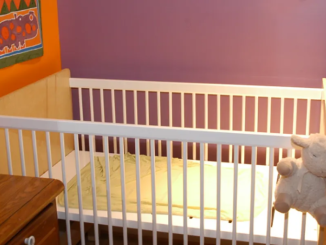Those nine months a mom carries her baby are filled with joy, anticipation, and a dose of uncertainty. What the new parents hope for is their bundle of joy to be healthy. Sadly, that is not always the case.

Jennie Wilklow, from Highland, New York, couldn’t wait to meet her daughter. She and her husband were over the moon to hold her in their arms. All the ultrasounds and doctor’s appointment suggested the baby was healthy, so they were eased and never thought sweet Anna would be born with a condition that would change all of their lives forever.
Jennie delivered Anna via C-section at 34 weeks. Doctors told her she looked beautiful and that was all Jennie needed to hear at that point.
Shortly after, the proud mom heard her daughter cry, and that was just another sign that everything was right with her little jewel.

When her husband visited Jennie, he was strangely silent and looked worried and puzzled.
“My husband’s silence scared me; he just sat in shock as the doctor left, and I prodded for more info,” Jennie shared with Cafe Mom.
“He just kept saying, ‘It’s bad.’ What does that even mean? I thought in my head. He told me, ‘Jennie, I looked in her eyes, and she has the most beautiful soul.’”
Anna was diagnosed with harlequin ichthyosis, a rare condition that causes thick diamond-shaped plates that are separated by deep cracks. “As they tried frantically to help her, her skin hardened within seconds (of birth). After hardening, it began to split, causing open wounds all over her body,” Jennie told Cafe Mom.
\

Although doctors weren’t sure she would survive, Anna beat the odds and is thriving. “She was beauty in the purest form,” her mom said.
There isn’t cure, and the treatment is quite demanding as it requires constant baths and keeping the skin as much moisturized as possible. “Every couple of hours I covered her with Vaseline and bathed her for many hours of the day. I had dreamed for years about the things my baby would wear, and though it seemed so trivial, it was what I struggled with most,” Jennie said.

In an attempt to raise awareness about this condition, Jennie posts photos of Anna on her Instagram page harlequindiva. She opens up about the everyday struggles and what it is like to have a child with harlequin ichthyosis.
“Anna captured everyone’s hearts because she is the purest form of perfection. Doing the work every day is simple when I’m doing it for her, and with every new accomplishment, the world celebrates with me,” Jennie told Cafe Mom.
She adds, “I now understand that I was given her because of the love I already carried in my heart for my daughter. Anna was meant for me, and I for her, and together we will show the world what true beauty is.”

from Action Films
Over nearly five decades in Hollywood, Liam Neeson has played some of the screen’s most memorable characters—from a wise Jedi Master to a compassionate hero in dark times, a grieving widower, and, most famously, a relentless father in Taken that propelled him to action stardom.
Now, at 72, Neeson is contemplating retirement from action films, admitting he’s unsure if he can keep up with the intense physical demands. “It has to end at some point,” he shared, hinting that his days of throwing punches may be winding down.
Liam Neeson’s illustrious career has spanned a variety of genres, highlighting his versatility. The Irish actor first rose to fame in the early 1990s with his acclaimed portrayal of Oskar Schindler in Schindler’s List, earning him widespread recognition and award nominations.
Through the following years, Neeson built a diverse portfolio, from romantic dramas to his turn as a Jedi Master in Star Wars. But in 2008, he reinvented himself as an action hero with Taken, where his character’s “very special set of skills” became instantly iconic. This shift surprised fans of Love Actually, who saw him transition into high-stakes thrillers in his mid-50s, proving his appeal across film genres.

Taken became a blockbuster, and Neeson’s portrayal of Bryan Mills, a retired CIA agent determined to save his kidnapped daughter, deeply resonated with audiences. “It just seemed to have touched something in the psychic nerve of moviegoing audiences,” he told People in an October 2024 interview.
The character of Mills became an iconic action role, with Neeson’s famous phone threat solidifying him as an unlikely but compelling action hero. The success of Taken led to two sequels and a host of other action roles, making Neeson a trusted name in the genre.
Hans Petter Moland, who directed Neeson in Cold Pursuit (2019) and the upcoming Thug, noted Neeson’s unique intensity. “When he’s deeply in character, you can see the hurt and pain. He really becomes that person,” Moland said.
Despite his successful action career, Neeson has shared that he’s considering stepping back due to his age. Even at 72, he continues to do many of his own stunts, working closely with his longtime stunt double, Mark Vanselow, who has coordinated his stunts since Taken. Neeson has maintained, “You can’t fool audiences. I don’t want Mark to be doing my fight scenes.”
The Oscar-nominated actor reflected, “Maybe by the end of next year. I think that’s it.” But Neeson isn’t saying goodbye to acting altogether—he’s simply changing lanes.
In a surprising turn, he’s ready to take on comedy. Neeson recently wrapped filming on The Naked Gun, a remake of the 1988 comedic crime classic. In the 2025 film, Neeson will play the beloved detective Frank Drebin, originally portrayed by Leslie Nielsen, with Baywatch star Pamela Anderson as his co-star.
“I’m totally smitten with her. I can’t say enough good things. She’s incredibly funny,” Neeson said, while admitting he’s nervous about comedy, saying, “I really don’t know if I can pull it off.” However, Anderson assured fans that he’s simply being modest. “It was hard to keep a straight face during our scenes together,” she told People.
What are your thoughts on Liam Neeson’s decision to step back from action roles? Let us know, and share this story to hear from other fans!



Leave a Reply